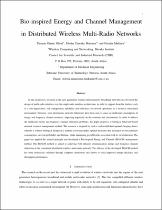 ResearchSpace
ResearchSpace
Bio-inspired energy and channel management in distributed wireless multi-radio networks
JavaScript is disabled for your browser. Some features of this site may not work without it.
- ResearchSpace
- →
- Research Publications/Outputs
- →
- Journal Articles
- →
- View Item
| dc.contributor.author |
Olwal, TO

|
|
| dc.contributor.author |
Masonta, Moshe T

|
|
| dc.contributor.author |
Mekuria, Fisseha

|
|
| dc.date.accessioned | 2014-08-15T13:06:31Z | |
| dc.date.available | 2014-08-15T13:06:31Z | |
| dc.date.issued | 2014-06 | |
| dc.identifier.citation | Olwal, T.O, Masonta, M.T and Mekuria, F. 2014. Bio-inspired energy and channel management in distributed wireless multi-radio networks. IET Science, Measurement & Technology, pp 1-10 | en_US |
| dc.identifier.issn | 1751-8822 | |
| dc.identifier.uri | http://digital-library.theiet.org/content/journals/10.1049/iet-smt.2013.0204?crawler=true&mimetype=application/pdf | |
| dc.identifier.uri | http://hdl.handle.net/10204/7605 | |
| dc.identifier.uri | https://ieeexplore.ieee.org/document/6985787 | |
| dc.identifier.uri | DOI: 10.1049/iet-smt.2013.0204 | |
| dc.description | Copyright: 2014 Institution of Engineering and Technology (IET). This is the ABSTRACT ONLY. The definitive version is published in IET Science, Measurement & Technology, pp 1-10 | en_US |
| dc.description.abstract | In the recent past, research in the next generation wireless heterogeneous broadband networks has favoured the design of multi-radio interface over the single radio interface architectures in order to support desirable features such as a self-organisation, self-configuration, reliability and robustness of network operations in a resource-constrained environment. However, such autonomous network behaviours have been seen to cause an inefficient consumption of energy and frequency channel resources, impacting negatively on the economy and environment. In order to address the inefficient energy and frequency channel utilisation problems, this paper proposes a biological behaviour-based network resource management method. The research is inspired by such a well-established optimal foraging theory whereby a solitary biological forager in a random ecosystem makes optimal decisions that maximise its own nutrients consumption, survival probability and lifetime, while minimising possible risks associated with its own behaviour. The paper has applied this natural principle and developed a Bio-inspired Energy and Channel (BEACH) management method. The BEACH method is aimed at achieving both efficient communication energy and frequency channel utilisation in the considered distributed wireless multi-radio network. The efficacy of the developed BEACH method has been extensively validated through computer simulations and shown to yield improved energy-efficiency and throughput performance. | en_US |
| dc.language.iso | en | en_US |
| dc.publisher | Institution of Engineering and Technology (IET) | en_US |
| dc.relation.ispartofseries | Workflow;13220 | |
| dc.subject | Wireless broadband networks | en_US |
| dc.subject | Bio-inspired Energy and Channel management method | en_US |
| dc.title | Bio-inspired energy and channel management in distributed wireless multi-radio networks | en_US |
| dc.type | Article | en_US |
| dc.identifier.apacitation | Olwal, T., Masonta, M. T., & Mekuria, F. (2014). Bio-inspired energy and channel management in distributed wireless multi-radio networks. http://hdl.handle.net/10204/7605 | en_ZA |
| dc.identifier.chicagocitation | Olwal, TO, Moshe T Masonta, and Fisseha Mekuria "Bio-inspired energy and channel management in distributed wireless multi-radio networks." (2014) http://hdl.handle.net/10204/7605 | en_ZA |
| dc.identifier.vancouvercitation | Olwal T, Masonta MT, Mekuria F. Bio-inspired energy and channel management in distributed wireless multi-radio networks. 2014; http://hdl.handle.net/10204/7605. | en_ZA |
| dc.identifier.ris | TY - Article AU - Olwal, TO AU - Masonta, Moshe T AU - Mekuria, Fisseha AB - In the recent past, research in the next generation wireless heterogeneous broadband networks has favoured the design of multi-radio interface over the single radio interface architectures in order to support desirable features such as a self-organisation, self-configuration, reliability and robustness of network operations in a resource-constrained environment. However, such autonomous network behaviours have been seen to cause an inefficient consumption of energy and frequency channel resources, impacting negatively on the economy and environment. In order to address the inefficient energy and frequency channel utilisation problems, this paper proposes a biological behaviour-based network resource management method. The research is inspired by such a well-established optimal foraging theory whereby a solitary biological forager in a random ecosystem makes optimal decisions that maximise its own nutrients consumption, survival probability and lifetime, while minimising possible risks associated with its own behaviour. The paper has applied this natural principle and developed a Bio-inspired Energy and Channel (BEACH) management method. The BEACH method is aimed at achieving both efficient communication energy and frequency channel utilisation in the considered distributed wireless multi-radio network. The efficacy of the developed BEACH method has been extensively validated through computer simulations and shown to yield improved energy-efficiency and throughput performance. DA - 2014-06 DB - ResearchSpace DP - CSIR KW - Wireless broadband networks KW - Bio-inspired Energy and Channel management method LK - https://researchspace.csir.co.za PY - 2014 SM - 1751-8822 T1 - Bio-inspired energy and channel management in distributed wireless multi-radio networks TI - Bio-inspired energy and channel management in distributed wireless multi-radio networks UR - http://hdl.handle.net/10204/7605 ER - | en_ZA |





